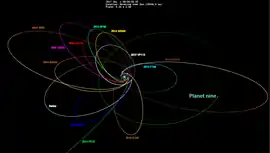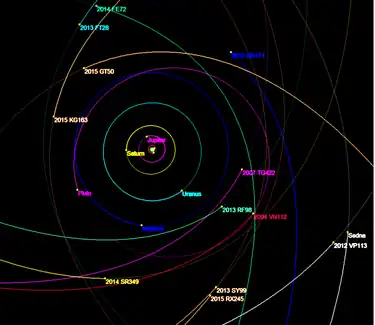2013 FT28
2013 FT28 is a trans-Neptunian object. The existence of the TNO was discovered on 16 March 2013 at Cerro Tololo Observatory, La Serena and revealed on 30 August 2016.[2]
 The orbit of 2013 FT28 (right side in light blue, click image to enlarge) and other extreme detached objects, along with the hypothetical Planet Nine's orbit on the right | |
| Discovery | |
|---|---|
| Discovered by | |
| Discovery date | 16 March 2013 |
| Designations | |
Designation | 2013 FT28 |
| Orbital characteristics | |
| Epoch 31 July 2016 (JD 2457600.5) | |
| Uncertainty parameter 4 | |
| Observation arc | 1089 days (2.98 yr) |
| Aphelion | 546 AU (barycentric)[1] |
| Perihelion | 43.6 AU |
| 296 AU (barycentric)[1] | |
| Eccentricity | 0.86 |
| 5051 yr (barycentric)[1] | |
| 357.15° | |
| Inclination | 17.3° |
| 217.7° | |
| 40.2° | |
| Physical characteristics | |
| Dimensions | 100–400 km |
| 24.3 | |
| 6.7 | |
2013 FT28 is the first high semi-major axis, high perihelion extreme trans-Neptunian object that is anti-aligned with the other known extreme trans-Neptunian objects such as Sedna and 2012 VP113, i.e. its longitude of perihelion differs by 180° from other objects. The orbit of 2013 FT28 appears stable though simulations showed that it may have some resonant interaction with the known giant planets.[3]
Its argument of perihelion is similar to that of another TNO, 2015 KG163.

Closeup of current position near perihelion, passing downward from the upper left of this view
References
- Horizons output. "Barycentric Osculating Orbital Elements for 2013 FT28". Retrieved 8 February 2017. (Ephemeris Type:Elements and Center:@0)
- "New Solar System objects revealed". bbcnews. 30 August 2016. Retrieved 19 February 2017.
- Sheppard, Scott S.; Trujillo, Chadwick (2016). "New Extreme Trans-Neptunian Objects: Towards a Super-Earth in the Outer Solar System". The Astronomical Journal. 155 (6): 221. arXiv:1608.08772. Bibcode:2016AJ....152..221S. doi:10.3847/1538-3881/152/6/221. S2CID 119187392.
External links
 Media related to 2013 FT28 at Wikimedia Commons
Media related to 2013 FT28 at Wikimedia Commons- 2013 FT28 at AstDyS-2, Asteroids—Dynamic Site
- 2013 FT28 at the JPL Small-Body Database
This article is issued from Wikipedia. The text is licensed under Creative Commons - Attribution - Sharealike. Additional terms may apply for the media files.